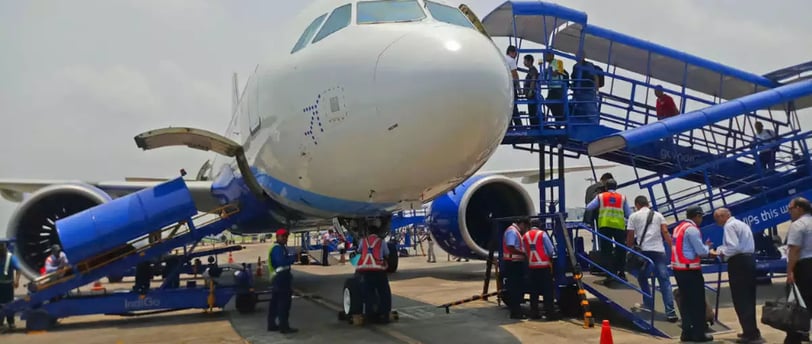Add your promotional text...
Indian Airports Soaring High: ₹60,000 Crore Capex Planned to Handle 65 Million More Passengers by 2027
Synopsis: Aiming to accommodate an additional 65 million passengers annually, Indian airports are set to undergo a transformation with a massive ₹60,000 crore investment through FY 2027. This ambitious growth plan is backed by an 8–9% CAGR in passenger traffic, tariff hikes, and an expanding airport ecosystem, promising robust revenue growth and improved infrastructure.
TOP STORIES
By Vishwas Saxena
12/12/20243 min read


The Next Phase of Indian Aviation Growth
Indian aviation is on the brink of a significant leap forward, with airports projected to invest ₹60,000 crore in infrastructure development over the next three years. According to a report by Crisil Ratings, this capital expenditure marks a 12% increase from the ₹53,000 crore spent between FY 2022 and FY 2024. This strategic investment aims to boost capacity by adding infrastructure to support an additional 65 million passengers per annum.
The report highlights that this growth is underpinned by the rise in passenger traffic, increased tariffs, and higher spending within the airport ecosystem. These factors are set to drive the revenue of private airports at an impressive average annual growth rate of 17% between FY 2025 and FY 2027.
Passenger Traffic: A Tale of Unprecedented Growth
Manish Gupta, Senior Director and Deputy Chief Ratings Officer at Crisil Ratings, stated that Indian airports are expected to witness a Compound Annual Growth Rate (CAGR) of 8–9% from FY 2025 to FY 2027. This surge comes after handling 376 million passengers in the previous fiscal year.
Key Drivers of Growth:
Domestic Traffic: Comprising over 80% of total air traffic, domestic demand is fueled by a rise in business and leisure travel, alongside government initiatives to make air travel accessible.
International Traffic: Improved connectivity, easing visa restrictions, and an uptick in business travel are expected to drive international passenger volumes.
Regional Connectivity: A Crucial Component
The government’s ambitious ‘Ude Desh ka Aam Naagrik’ (UDAN) scheme has been pivotal in enhancing regional air connectivity. As of July 2024:
84 airports and 579 routes have been operationalized under this scheme.
Regional air traffic now contributes 2% of domestic air passenger volume.
These regional routes not only make air travel accessible to smaller towns but also serve as feeder traffic sources for larger metro airports, further enhancing their operational efficiency.
Private Airports: The Backbone of Expansion
Private airports play a critical role in India’s aviation ecosystem, contributing to 60% of total passenger traffic and an astounding 95% of private passenger traffic as of FY 2024. Their credit profiles remain strong due to:
Revenue Growth: Aided by passenger traffic increases and tariff hikes.
Predictable Regulations: Ensuring stable operations and funding access.
Infrastructure Investment: To accommodate growing traffic and enhance passenger experience.
Economic Impact of Increased Air Traffic
The projected rise in passenger traffic also has broader economic implications:
Revenue Growth for Airports: Estimated at 17% CAGR between FY 2025 and FY 2027.
Enhanced Airport Ecosystem Spending: Includes ancillary services like retail, food, and parking.
Improved Regional Penetration: Strengthening local economies and providing new opportunities for tourism and trade.
October 2024: A Snapshot of Growing Momentum
The Directorate General of Civil Aviation (DGCA) reported a 5.3% rise in domestic air passenger traffic in October 2024, reaching 1.36 crore passengers compared to 1.26 crore in October 2023. This steady growth signals the resilience of the Indian aviation sector amidst global challenges.
The Road Ahead: Challenges and Opportunities
While the outlook for Indian aviation is optimistic, challenges remain:
Infrastructure Bottlenecks: Ensuring timely completion of expansion projects.
Financial Stability: Managing the balance between capex investments and profitability.
Policy Implementation: Effective execution of government initiatives like UDAN.
However, the opportunities far outweigh the challenges. The sector’s ability to connect millions more travelers and boost economic activity across regions makes it a cornerstone of India’s growth story.
A High-Flying Future for Indian Aviation
The ₹60,000 crore investment plan for Indian airports is a testament to the sector’s resilience and potential. With passenger traffic set to grow at an 8–9% CAGR and revenue projections indicating robust growth, the aviation industry is poised to soar higher than ever.
This transformation will not only enhance India’s global connectivity but also create a ripple effect across industries, boosting tourism, trade, and regional development. As India takes to the skies, the aviation sector promises to be a key driver of the country’s economic ascent.
